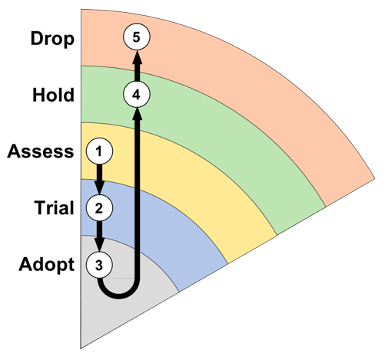Just as software, projects undergo a common lifecycle. For the purpose of this Project Radar, we have defined the following stages in a project lifecycle that are of interest here:
Assess → Trial → Adopt → Hold → Drop
The rings represent the position of the projects in terms of their contractual project lifecycle. It assumes that projects generally progress satisfactorily towards their goals and outcom, relying on this being ensured by the funding programmes own checks and balances. In the case of EU H2020, these are the regular project reviews, and the selection of expert reviewers for the project by the Commission.
Labels reflect the project lifecycle phases indicated above. They closely resemble the ascension through the Technology Readiness Levels (TRL) that are ubiquitous in the technology and engineering sectors.

As this progression through the rings is not immediately clear, a red demarcation circle in the radars illustrate the border between the "Assess" and "Hold state" that, while visual neighbours, are very different stages in a project lifecycle.
Technical criterion: The project is running, and has more than 6 months to go.
The project is still running, and has still a considerable amount of time to further mature their results and outputs, yet needs to think about how it will play out the final stretch of project lifetime.
Recommendation: Study the project’s high-level description and designated outputs, and compare with your own strategy and needs. If there is a match, put the project on a personal/specific short-list for further check-up later.
Technical criterion: The project is running, and has less than 6 months to go.
The project is now seriously busy finalising its planned outputs. That might be a piece of software, an innovative algorithm, or a study whose results may impact your own work. Some of the planned work might have been dropped in order to reach the stated goal for more important outputs.
Recommendation: Check back regularly with the project (either actively or passively) to see how the output you are interested in is progressing. Refine your shortlist based on the results of that exercise; expect your shortlist getting smaller unless there are new projects in the pipeline that stock it up again. For those you consider specifically mature, you should consider first practical trials of integrating the output into your portfolio – not to accomplish it straight away, but to anticipate the level of “integration pain” you may experience later. Click on the project’s score card and contact then directly through their mini-site.
Technical criterion: The project finished less than 1 year ago.
The project has finished and published its results and outputs. Project output are usually considered stable and the focus of uptake into production. There may be further changes to it, especially with active communities supporting it, but expect at least a temporary significant drop in speed of change in this timeframe.
Recommendation: For projects that stayed on your shortlist unto this stage, this is the time to start serious integration trials with stable versions of the output. In the case of study results, or non-IT related outputs, the expected integration pain may affect your overall business strategy and cause changes in operations and processes, rather than technical integration challenges that present themselves with IT integrations.
Technical criterion: The project finished more than 1 year ago.
If you haven’t already decided to integrate the project’s outputs into your own business, or more neutrally, operations at large, projects in this“stage may still have value to you, but you need to understand the how the then published outputs have fared until now, and may fare in the future.
Project results in the IT sector, and especially in the currently very dynamic cybersecurity domain age very quickly, as competition is fierce, and many outputs are superseded by technical innovation, or other projects simply having been faster or more efficient in their execution.
Recommendation: Look out for the support infrastructure and community for the outputs of that project. Is alive and active? Is it expanding or contracting? As far as concepts and new knowledge is concerned, how well are outputs from about 2 years ago still valid? Be very sure about the impact and skills required when deciding to integrate outputs of that age.
Technical criterion: The project finished more than 2 years ago.
The project has seen its sunset quite a while ago. At this point in time, you will know whether its outputs have succeeded or not. If it did, then it is usually disassociated from the original project and has formed a life and purpose of its own, and you can focus on the software, hardware, knowledge, or insight itself. As far as tracking and collecting project related information, it is safe to consign it to the long-term archives.
Recommendation: For all intents and purposes, projects at this stage are safe to discard from your attention.
